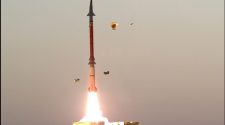
Media playback is unsupported on your device
California’s SpaceX company says it will work constructively with the scientific community to fix the brightness of its satellites.
The firm has come under fire for the brilliance of its Starlink spacecraft, which are being launched to deliver broadband to every corner of the globe.
One hundred and eighty of the platforms have already been sent to orbit with thousands more to follow.
Astronomers fear they will interfere with telescope observations.
Pictures of the night sky showing long streaks as the Starlinks cross the field of view have now become a heightened complaint.
But a SpaceX executive told the American Astronomical Society conference in Hawaii on Wednesday that the company was seeking ways to make the platforms much less intrusive.
Patricia Cooper, the firm’s vice president of satellite government affairs, told a specially convened session that delegates’ science was valued and there was no desire to impede it.
The company is experimenting with a new coating that will hopefully reduce the reflectivity of the Starlinks. Of the 60 new satellites sent up on Monday, one in the batch had this corrective paint job.
Detailed coordinates of the spacecraft are also being shared so observations of the sky can be planned to avoid the objects’ passing.
“We don’t know yet if these mitigations are useful and effective. We tend to work very quickly. We tend to test, learn and iterate,” she was reported as saying by the Space News reporter Jeff Foust.
Astronomers at the meeting said it would not be before the end of February – when the “dark satellite” had reached its operational orbit – that a proper assessment could be made of the coating experiment.
Image copyright
Victoria Girgis/Lowell Observatory
On launch, the Starlinks are released in a train that produces streaks in long exposure images
The AAS has put together a committee to investigate the impact of so-called mega-constellations.
It is not just SpaceX which is rolling out a giant network of satellites. Other companies plan to do the same – some to deliver telecommunications services, others to acquire rapid and repeat imagery of the Earth’s surface.
Prof Patrick Seitzer, from the University of Michigan, Ann Arbor, said everybody had been surprised at the brightness of the Starlinks – including SpaceX.
He listed the difficulties posed to astronomy by their current reflectivity. The Michigan astronomer described how they produced multiple streaks and ‘ghosts’ in telescope pictures, how their brightness could saturate detectors, and generate cross-talk in electronics.
SpaceX may have more than 1,500 Starlinks in orbit by the year’s end, but is proposing an eventual constellation that could grow from 12,000 to more than 40,000.
“Mega-constellations in Low Earth Orbit are coming and they are coming fast,” said Prof Seitzer. “The new satellites are brighter than 99% of objects in orbit. If the (initial) 1,584 Starlinks was the only constellation to be launched, with six to nine visible above you at any one time, astronomers could handle it. But there are press releases sent out for 10 or 20 times that (number of satellites). It’s just the start.”
The first threshold he said SpaceX had to meet was making sure the Starlinks could not be seen with the naked eye when they were in their operational orbit some 550km above the Earth. The second threshold was to eliminate the saturation effect in the detectors of large professional telescopes.
Prof Seitzer said the facility that stood to be worst affected was the forthcoming NSF Vera C Rubin Observatory (formally called the Large Synoptic Survey Telescope). This will be making a map of the entire sky every three days. Its wide field of view and remarkable sensitivity to anything that’s moving in sight of its detectors will make Vera Rubin especially vulnerable to Starlink interference.
There is a dedicated team now of telescope and SpaceX engineers looking specifically at measures to help this one observatory.
Image copyright
LSST
The forthcoming NSF Vera C Rubin Observatory could be badly affected
While much of the focus has been on the optical visibility of satellites, there is growing concern also about radio interference.
Dr Harvey Liszt, from the National Radio Astronomy Observatory (NRAO), Charlottesville, said his science had been fighting since the 1970s and 80s to get satellite operators to adhere to frequency regulations. “Welcome to my world,” he said of the present fuss of the Starlinks’ brightness.
Dr Liszt raised the issue of radar imaging satellites. Once rare, these spacecraft, which can map the Earth’s surface day or night and in all weathers, are about to see their numbers shoot up as well.
“Synthetic Aperture Radar (SAR) if pointed at a radio telescope when the telescope is pointed in its direction will burn out the radio astronomy receiver,” the Charlottesville research told reporters.
Image copyright
GPS.gov
Artwork: The first GPS satellites were notorious for causing radio interference for astronomy
One of the radar constellation companies named by Dr Liszt as posing a potential problem is Finland’s Iceye.
The firm’s CEO, Rafal Modrzewski, said his team took its responsibilities seriously, and that it continued to investigate any potential risks Iceye’s technology might pose to the global space community, both in orbit and on the ground.
“Most importantly in this topic, Iceye complies with international regulation regarding our allocated bands,” he told BBC News.
“Mitigating any potential or perceived risks to sensors on ground can additionally be done proactively by tracking applicable SAR satellite orbits to avoid clashes with instrumentation, and in the case of Iceye, by also working with us if there are any remaining concerns.”
While the AAS committee says it is encouraged by the open dialogue it is having with constellation companies, there are those within the astronomy community who feel the response from its leadership is too weak and too slow.
They worry the battle may already have been lost.
Prof Mark McCaughrean, a senior scientific adviser with the European Space Agency (Esa) and an infrared astronomer, tweeted: “It’s a matter of asymmetric timescales: on (the) one hand, scientists are used to conducting thorough studies over years, while on the other, industry is simply going ahead and launching 60 new satellites every fortnight.”
Prof Seitzer remarked: “I think all we can do at this point is move rapidly; we just can’t wait for the regulatory environment (to catch up). We need to convince SpaceX that it’s in their best interest to move rapidly and solve this problem quickly and set the standard for everybody else.”
[email protected] and follow me on Twitter: @BBCAmos
















